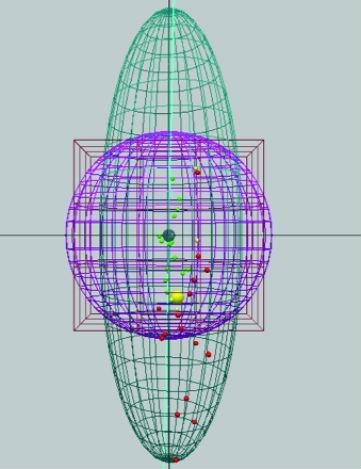Below is a comprehensive guide to defining color tolerances and sample presentation practices to achieve accurate color measurements.
is a comprehensive guide to defining color tolerances and sample presentation practices to achieve accurate color measurements.
by Konica Minolta
Will the difference between a sample color and the standard be acceptable?
The ultimate goal of implementing a color quality process is to get the color you want, or that the customer wants in the final product through an efficient and simplified process. If the color of a product does not meet the standard, customer satisfaction is in jeopardy and increases the amount of work and costs.
Establishing color tolerances objectively within the color quality process is an effective way to ensure color consistency and accuracy throughout the supply chain, and from one batch of materials to another.
A color tolerance is a limit to knowing how much is the color difference between a sample and the standard so that the sample can be considered acceptable.
Using instruments for color evaluation, tolerance values should be defined internally, or between suppliers and customers, and used in quality control to determine whether or not the sample passes inspection. To set a color tolerance, the following steps must be followed:
1. Define a color standard: What is the color that is desired in the final product?: Based on what has already been expressed above, a standard must be defined internally or between suppliers and customers. In addition, it is necessary to use instruments for color evaluation, measure the color you want to match for the final product and record your color values.
2. Perform visual evaluations: What colors are visually acceptable?: Visual evaluations are performed as a starting point to define a tolerance range. For starters, gather samples or batches of color that appear similar to the standard and evaluate them visually using a light booth. These samples or batches should be markedly different from the standard to help identify the greatest difference in color even though they are considered acceptable for the standard. After visual assessments are done, choose all color swatches that are considered visually acceptable.
Keep in mind that the sensitivity of the human eye varies from person to person making the color appear differently to each individual. Therefore, it is recommended to use a committee of people, either internal or client to confirm these visual assessments and maintain consistency.
3. Define tolerance values: What is the acceptability range?: Using the color samples chosen in visual evaluations, make measurements using a colorimeter or spectrophotometer. Record your color values such as DL*, Da*, Db*, DC*, Dh, and DE. In most cases, CIE values are used to establish these tolerances. The color with the values furthest from the standard can be used as the maximum limit and the color values of the standard can be used as the minimum limit. Color that falls within this tolerance range is considered acceptable, while color that falls outside this tolerance range is rejected.
Please note that these values must be re-evaluated throughout the manufacturing process and must be continuously refined to identify ideal tolerance values for your application.
4. Establish a tolerance system: rectangular, circular or elliptical?: Tolerance values must correlate to the human eye so that color is both visually and numerically acceptable. This ensures consistency from one batch of materials to another. For this, the use of CMC or DE2000 tolerance systems is recommended because the ellipsoids in these systems are based on the color discrimination threshold of the human eye. Both systems were developed to improve the weaknesses of other tolerance systems and improve accuracy.
If the rectangular tolerance system of L * a * b * is used, the tolerance values should be set for each DL * , Da * and Db * component, so that it can be identified which coordinate, if any, has exceeded the limit ΔE *, the total color difference, can be used as long as the user evaluates the individual attributes. This system, however, is not recommended because the human eye sees color as an ellipse, not as a rectangle or box. The color near the edge of this tolerance box may be numerically acceptable but visually unacceptable to the observer, causing a disagreement between the instrument and the observer. This disagreement also occurs with CIE DE*ab, a circular system of tolerance, and is not recommended.
The images below illustrate a set of samples compared to a standard in SpectraMagic NX software. The cube or box, refers to CIE DL *, Da * and Db *, the circle or sphere, represents DE * ab color difference, and the ellipsoid represents DE2000. The ellipse, or color difference formula, is more representative of how the human eye perceives color.
With the introduction of color measurement instruments such as colorimeters and spectrophotometers, it is possible to quantify color.

Figure 1. Color tolerance.
Colorimeters are sophisticated color measuring instruments that make "myth" measurements based on the passage of light through the three primary filters, red, green and blue, which simulate the way the human eye is sensitive to light. Tristimulus color measurements provide information about the amount of these three components present in the light reflected or transmitted by a product. This information can be transmitted to adjust the color components.
A tristimulus colorimeter has several features such as being a reasonably low price, compact size, increased mobility and simple operation. Colorimeters can easily determine colorimetric values under a simple illuminant and are mainly used for reflectance measurements. However, a colorimeter is not suitable for complex color analysis such as metamerism and color strength.
Spectrophotometers are the most accurate and sophisticated color measurement instruments available for color quality control and color formulation. Spectrophotometers perform color measurements of the entire spectrum. They measure the total reflectance or transmittance of an object across the total spectrum of visible wavelengths, from 400mm to 700mm. The high precision of these instruments make them the instruments of choice for color formulation, specification of standards and tolerances, communications along the supply chain and color quality control.
A spectrophotometer has high accuracy and greater versatility. It is applicable for more complex color analysis since it can determine the spectral reflectance at each wavelength. However, spectrophotometers can be more expensive than colorimeters. Always consider what level of accuracy each measured color has to have before selecting the type of instrument to use in your application.
The non-contact online color measurement system provides critical color information in real time at the time of the control process and at high speed. Using multidirectional lighting and non-contact sensors, this system is ideal for textured, uneven and multidirectional materials. In-line color measurement systems are also capable of measuring the light transmitted from clear plastics and films. The system provides accurate, high-speed color information instantly detecting off-specification conditions, alerting operators and control systems so corrections can be applied immediately.
Figure 2.
In addition to establishing standardized color measurement and evaluation procedures, standardized formulation conditions are also required to maintain consistency and improve efficiency through a color matching process. This includes maintaining equipment and defining conditions that can have an impact on the formulation of results.
- Maintain formulation teams to make sure they work properly
- Monitor the weight of dyes and pigments to ensure consistency is maintained
- Establish precise measurement methods for substrates, dyes, pigments or auxiliaries based on the weight of the object being colored
- Calibrate balances and color measuring instruments regularly to maintain accuracy and optimal performance
- Maintain the light booth used for measurements by periodically replacing the lamps as recommended by your supplier
- Set a fixed room temperature so as not to cause a change in the color of the samples
- Standardize processes from start to finish so as not to impact the final result, including sample creation, mixing, exposure time after mixing, oven temperature for drying, drying time
By standardizing color formulation processes and establishing a controlled environment, users can work more effectively and match color standards with less time and waste.
The ultimate goal when implementing a color process is to obtain the desired color – or that consumers want – in the final product through an efficient and harmonious process. While this depends on what area you are in within the production process, knowing how to communicate and define the color to others accurately, knowing how to formulate or match the color of the sample with your standard and knowing how to properly measure and evaluate the samples using high-precision instruments and software will ensure that the final product meets the defined standard color.
* Konica Minolta Sensing is a company that among its lines has color measurement instruments to effectively formulate, evaluate and control color and appearance in different industries. For more information visit sensing.konicaminolta.com.mx

























Leave your comment